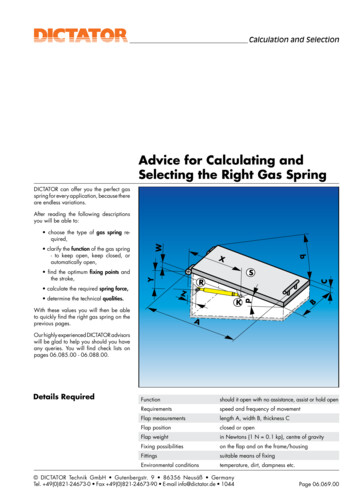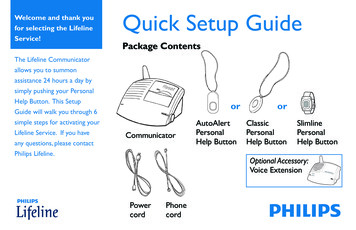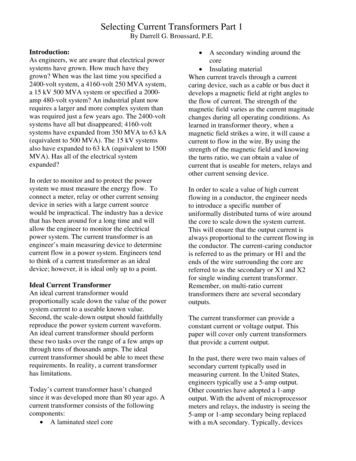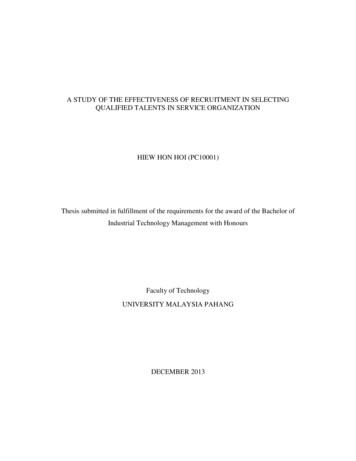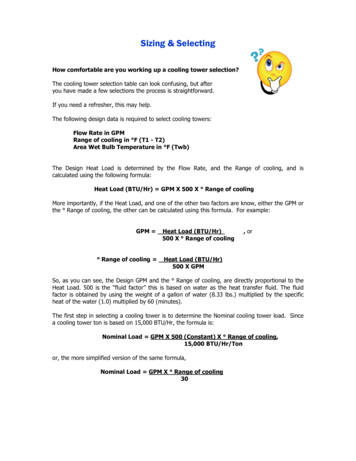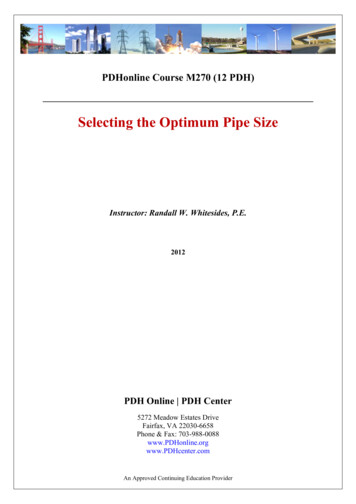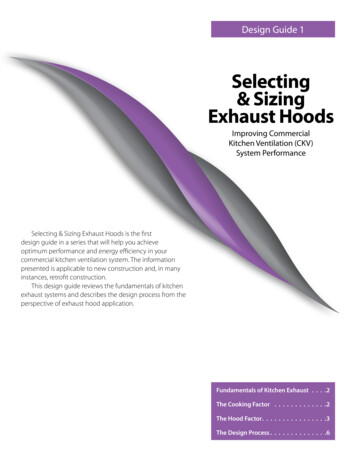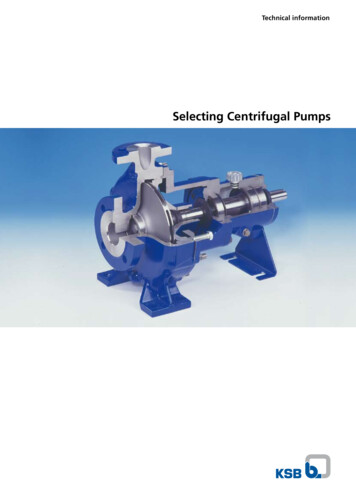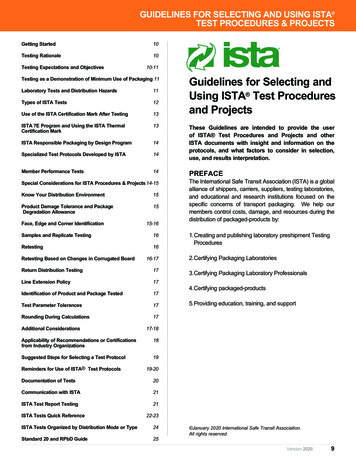
Transcription
GUIDELINES FOR SELECTING AND USING ISTA TEST PROCEDURES & PROJECTSGetting Started10Testing Rationale10Testing Expectations and Objectives10-11Testing as a Demonstration of Minimum Use of Packaging 11Laboratory Tests and Distribution Hazards11Types of ISTA Tests12Use of the ISTA Certification Mark After Testing13ISTA 7E Program and Using the ISTA ThermalCertification Mark13ISTA Responsible Packaging by Design Program14Specialized Test Protocols Developed by ISTA14Member Performance Tests14Special Considerations for ISTA Procedures & Projects 14-15Know Your Distribution Environment15Product Damage Tolerance and PackageDegradation Allowance15Face, Edge and Corner Identification15-16Samples and Replicate Testing16Retesting16Retesting Based on Changes in Corrugated Board16-17Return Distribution Testing17Line Extension Policy17Identification of Product and Package Tested17Test Parameter Tolerances17Rounding During Calculations17Additional Considerations18Suggested Steps for Selecting a Test Protocol19PREFACEThe International Safe Transit Association (ISTA) is a globalalliance of shippers, carriers, suppliers, testing laboratories,and educational and research institutions focused on thespecific concerns of transport packaging. We help ourmembers control costs, damage, and resources during thedistribution of packaged-products by:1.Creating and publishing laboratory preshipment TestingProcedures2.Certifying Packaging Laboratories3.Certifying Packaging Laboratory Professionals4.Certifying packaged-products5.Providing education, training, and support19-20Documentation of Tests20Communication with ISTA21ISTA Test Report Testing21ISTA Tests Quick ReferenceThese Guidelines are intended to provide the userof ISTA Test Procedures and Projects and otherISTA documents with insight and information on theprotocols, and what factors to consider in selection,use, and results interpretation.17-18Applicability of Recommendations or Certificationsfrom Industry OrganizationsReminders for Use of ISTA Test ProtocolsGuidelines for Selecting andUsing ISTA Test Proceduresand Projects22-23ISTA Tests Organized by Distribution Mode or Type24Standard 20 and RPbD Guide25 January 2020 International Safe Transit Association.All rights reserved.Version 20209
GUIDELINES FOR SELECTING AND USING ISTA TEST PROCEDURES & PROJECTSGETTING STARTEDFollowing are four straightforward suggestions to improveprotective packaging effectiveness and move toward theISTA Vision.1. Test the Package.If you are not regularly using a laboratory packageperformance test, start now. Even a simple lab test usedwisely is preferable to trial and error or total reliance on fieldexperience.2. Know Your Distribution Environment.Find out more about how products move, including thevariety of channels used to move your goods. If you are asupplier to shippers, help them explore this information. Usethis knowledge to identify sources of distribution hazardsand observe or measure them. Use this knowledge toreduce exposure to hazards of distribution, to help specifythe performance of packages, and to select an appropriatelaboratory test protocol.3. Continuously Review and Improve.Distribution hazards change, as do packaging materials.Review and retest even the most successful designsperiodically. Rapid situation changes, such as new marketsor distribution strategies, require immediate attention.4. Stay Up to Date.Take every opportunity to learn more about your productsand distribution, learn about new technologies andprocedures, and exchange knowledge with others who havesimilar concerns. Educational opportunities, such as ISTA’sannual TransPack Forum , are a good source of update.The ISTA Certified Packaging Laboratory Professional(CPLP) program and the Responsible Packaging by Designprogram are excellent educational and recognition tools.Find out more from ISTA Headquarters or visit www.ista.org.TESTING RATIONALEThe need for testing comes from the difficulty of predictingwhat will happen in large-scale operations, coupled withthe requirement to make decisions prior to implementation.Essentially, every test comes from the need to makea decision. The test results provide the decision-makerwith information to help maximize correct decisions. Thedecisions supported by preshipment performance testingof transport packaging are typically about how well thepackage will protect the contents during distribution.Testing can also be a mandated activity as part of apackage development, new product release, or engineeringmodification. This testing may be driven by organizational10www.ista.orgpolicy (corporate specification, for example), by regulatoryapplication (testing of packaging for hazardous materialsand dangerous goods, for example), or by customerrequirements (purchase specification, for example). Whilethese situations usually have little flexibility in test selection,they are still in the broad category of supporting decisionson packaging suitability.Other types of tests are available but a detailed treatment isoutside of the scope of this document. Material tests seek tocharacterize material performance for the use in design anddevelopment, such as cushion curves. Engineering testsseek to find a specific performance quantity, such as thedeceleration experienced by a product in a package whendropped from some height, as in an instrumented drop test.TESTING EXPECTATIONS ANDOBJECTIVESAn important consideration in the selection of a test protocolis the objective of running the test, i.e., what informationis needed to make the decision associated with this test.Broadly put, these specific objectives for each test might becategorized simply as screening or prediction.A screening test would be used to avoid serious problemsin shipment, usually damage to the product. This testobjective category is a common one, and can adequatelyfill the needs of many users. Screening tests give the userconfidence that the chances of serious transport damagehave been minimized and have the following generalcharacteristics: simple and inexpensive to perform widely available and accepted utilize simple equipment accommodate known and suspected severe hazards are not necessarily a simulation of the hazards ofdistribution achieve damage resistance by challenging the strengthand robustness of the product and package (a strongproduct/package resists damage).Prediction is a more difficult expectation for a preshipmentperformance test. While screening seeks to avoid seriousproblems, prediction must allow the user to foresee moresubtle effects, such as minor damage, occasional damage,or non-functional problems with the package. In an idealprediction situation, the tested samples and representativesamples of distributed products would be indistinguishable.This is not always entirely possible given the technology mixavailable today, but it is approachable.
GUIDELINES FOR SELECTING AND USING ISTA TEST PROCEDURES & PROJECTSPrediction allows the user to fine-tune cost and environmentalimpact as well as helping to avoid damage of all types. Bytesting incrementally reduced cost and material-contentdesigns, the near-optimum configuration could be achieved.Prediction might also allow the user to design a packagefor a repeatable low level of damage, consistent with anobjective of lowest overall system cost. Without a goodprediction test to represent field performance, this tradeoff of package cost and damage cost would be largelyguesswork.TESTING AS A DEMONSTRATION OFMINIMUM USE OF PACKAGINGISTA tests establish lower limits for packaged-productperformance, but in general do not set upper limits. Therefore,used in their most straightforward pass/fail fashion, ISTAtests do little to detect over-packaging situations. However,with the addition of a “reduce to damage” or “pass withminimum margin” approach, ISTA testing can be used forthe demonstration of minimum use of packaging. “Reduceto damage” means that if a packaged-product passes thetest it must be redesigned with less packaging and testedagain until an optimum level is reached. The “Reduce toDamage” approach is an essential component of an effortto make packaging more sustainable (as described in theResponsible Packaging by Design process guideline. “Passwith minimum margin” might involve subjecting a packagedproduct which has passed the test to increased severitylevels, determining when damage does occur, and thenverifying that those levels are not overly excessive.A “reduce to damage” or “pass with minimum margin”protocol employing screening tests should be used withextreme caution. Since screening tests may not wellrepresent actual field exposure in either intensity or type,the tests cannot be readily shown or proven to have a goodrelationship to the field damage. Using screening testscan perhaps be effective if coupled with a program of fieldmonitoring and feedback after package redesign. But thefar better approach is to use tests which provide a goodactual simulation of the distribution hazards.LABORATORY TESTS AND DISTRIBUTIONHAZARDSFour basic categories of hazards exist in distribution: Shock,Vibration, Compression, and Atmospheric. Each hazardcategory is reflected in a laboratory test method, althoughnot all ISTA Procedures and Projects include all testmethods. Within each test method are more specific teststhat are used to simulate specific hazards in distribution.The following table summarizes these relationships.DistributionHazardMajor TestCategoryAssociatedTest TypesHandling Dropand ImpactShockDrop free-fall rotational on hazard hazard impactIncline ImpactHorizontal ImpactVertical ImpactTransportationVibrationVibrationFixed Displacement rotary vertical linearVariable Displacement vertical horizontalRandom vertical horizontal multi-axisStacking LoadCompressionStatic (dead load)Machine apply & release apply & holdDynamic Load Under re constant cycleHumidity constant cyclePressure constant cycleTable 1 Hazard Categories and Test TypesIt is important to note that test protocols can evaluate theeffectiveness of packaging only for hazards represented inthe protocol. For example, a test procedure that does notinclude a compression test is unable to evaluate a packagedproduct’s resistance to warehouse stacking loads. Byknowing the distribution environment in detail (see GettingStarted, above), users can select an appropriate test toevaluate the performance of packaging in light of all knownhazards. Without this selection process, real hazards maynot be addressed as part of a package’s protective ability,and significant damage could result in spite of a test beingpassed.Version 202011
GUIDELINES FOR SELECTING AND USING ISTA TEST PROCEDURES & PROJECTSTYPES OF ISTA TESTSISTA test protocols are approved by Test Series Groups and by the ISTA Technical Division. New protocols are initially given thedesignation “Project” during their implementation phase. After a minimum one-year period, a “Project” is evaluated and will eitherbe adopted as an established “Procedure”, revised and kept as a “Project” for another period of time, or be dropped.ISTA has organized its test protocols into Series, as follows:1 Series: Non-Simulation Integrity Performance Tests.Challenge the strength and robustness of the product and package combination. Not designed to simulate environmental occurrences.Useful as screening tests, particularly when used as a consistent benchmark over time.2 Series: Partial Simulation Performance Tests.Tests with at least one element of 3 Series type General Simulation performance tests, such as atmospheric conditioning or mode-shapedrandom vibration, in addition to basic elements of a 1 Series type Non-Simulation Integrity test.3 Series: General Simulation Performance Tests.Designed to provide a laboratory simulation of the general damage-producing motions, forces, conditions, and sequences of transportenvironments. Applicable across broad sets of circumstances, such as a variety of vehicle types and routes, or a varying number ofhandling exposures. Characteristics will include simple shaped random vibration, different drop heights applied to the sample package,and/or atmospheric conditioning.4 Series: Enhanced Simulation Performance Tests.General Simulation tests with at least one element of Focused Simulation, such as test sequence or test conditions linked to actual knowndistribution. Project 4AB is currently the only protocol in this Series. 4AB is a web-based Enhanced Simulation Test Plan generator, withon-line access available at no charge to all ISTA members. Project 4AB closely ties the tests and sequence to a user-defined pattern ofdistribution, and includes a broad range of current and quantitative information on distribution environment hazards. See the Project 4ABsection of the ISTA website (www.ista.org) for more details.5 Series: Focused Simulation Guides **NOT AN ACTIVE SERIES**Guides for the creation of laboratory simulations based on actual field-measured and observed hazards and levels. The 5-Series are notperformance tests per se, but information and instructions related to establishment of user-defined Focused Simulation tests.6 Series: Member Performance Tests.Test protocols created by ISTA members or by ISTA in cooperation with a member company, to meet their particular purposes andapplications. The tests may be completely original, or may be modifications or variations or ISTA Procedures or Projects or other publishedand accepted tests. The tests are reviewed, approved, and formally accepted by successfully completing ISTA’s procedure for developingTest Protocols, per ISTA’s Technical Division Operating Guide.7 Series: Development Tests.These tests are used in the development of transport packages. They can be used to compare relative performance of two or morecontainer designs, but are not intended to evaluate the protection afforded packaged-products.1 Series protocols can reasonably be expected to be screening tests, with an increasing expectation of predictability throughSeries 5. Whether this is true in any specific case needs to be evaluated by comparing lab and distribution results. Thisimportant validation process should be a part of each user’s normal operations.12www.ista.org
GUIDELINES FOR SELECTING AND USING ISTA TEST PROCEDURES & PROJECTSUSE OF THE ISTA CERTIFICATION MARKAFTER TESTINGFor Packaged-Product Shippers:(this section does not apply to the Thermal Certification Mark used forISTA 7E insulated shipping containers, see the section that follows)The ISTA Transit Tested Certification Mark on a package isvisible proof that the packaged-product has passed a validISTA preshipment test. It gives the highest level of credibilityto the design, test, and packaged-product performanceverification process.For legal and management reasons, ISTA only offers thisservice when the lab which has done the testing is ISTACertified, the shipper/product manufacturer is an ISTAShipper member, and all other requirements set forth beloware met. ISTA cannot stand behind use of the Mark unlessit has appropriate control and oversight of all portions of theprocess.Due to the nature of ISTA Procedures and Projects, whichtake into account both the package and the product, ISTAdoes NOT certify packages for a packaging or servicesSupplier. The ISTA Certification Mark is a benefit for theShipper member only.In order for a package to be printed or labeled with the ISTATransit Tested Certification Mark, or to make claims of ISTApackaged-product certification, all points in the followingpolicy must be met: The packaged-product must be tested in an ISTACertified Lab (current with their lab certification). The testing must comply fully with all minimumrequirements of a current ISTA testing procedure orproject. All samples must pass the test(s). The results must be submitted to ISTA Headquarters(ISTA members can download our test report formsfrom the Member Center). The report must pass review and be approvedby ISTA Headquarters. Certification comes fromISTA, not the laboratory.Displaying the ISTA Transit Tested Certification Markon a distribution package indicates that the packagedproduct has passed a particular ISTA protocol. It does notnecessarily have a connection to damage claim payments,but shippers that display the Mark are certainly in a betternegotiating position.ISTA 7E PROGRAM AND USING THEISTA THERMAL CERTIFICATION MARKThe Thermal Certification Mark for Insulated ShippingContainer’s (ISC’s) is visible proof that the container hasbeen designed and tested in accordance to ISTA Standard20 by an ISTA Certified Thermal Testing Laboratory; theresults have been submitted to ISTA for independentreview and performance certification by an ISTA auditor. Ifthe documentation and results are approved, a certificationmark for that ISC will be issued for display on the ISC.In order for a package to be printed or labeled with theThermal Certification Mark for ISC’s, or to make claims ofISTA thermal certification, all points in the following policymust be met: The ISC must be designed following ISTA Standard20 by a licensed owner of ISTA Standard 20 andtested in an ISTA Certified Thermal Lab (current withtheir lab certification). The testing must comply fully with all minimumrequirements of ISTA 7E. All samples must pass the test(s). The thermal data package results must be submittedto ISTA. The report must pass review and be approved by anISTA Auditor. Certification comes from ISTA, not thetesting laboratory. The Mark, with package license number, may then beplaced on the ISC.Displaying the Thermal Certification Mark for ISC’s indicatesthat the container has been designed and tested inaccordance with ISTA Standard 20. It does not necessarilyhave a connection to damage claim payments. The shipper must be an ISTA member in good standing. The shipper must sign a license agreement to use theTransit Tested Certification Mark, and will be assigneda Manufacturer’s License Number. The Mark, with manufacturer’s license number, maythen be placed on the packaged-products.Version 202013
GUIDELINES FOR SELECTING AND USING ISTA TEST PROCEDURES & PROJECTSPackage TypeDistributionTypeIndividual PackagesUnitized / Pallet Loadup to 150 lbs. (68 kg)over 150 lbs. (68 kg)Parcel Delivery3A,6-FedEx-ANot ApplicableNot ApplicableLTL Ex-BManufacturingto DistributionCenterNot ApplicableNot Applicable3EDistributionCenter to Retail3FNot ApplicableNot C6-Amazon.com-SIOCNot ApplicableClub Store6-Sams Club6-Sams Club6-Sams ClubEuropeanConsumerGoods3KNot ApplicableNot ApplicableSpecializedFurniture2C2C2CThermal Testing/Testing ofInsulated ShippingContainers7D,7E7D,7ESituationalNot ApplicableNot tomotiveResuableUser Defined/Custom TestPlanningand the larger packaging community. Theseinclude tests for specific distribution modes, suchas parcel and LTL delivery and bulk shipments, forpackage types, such as unitized loads and reusablecontainers, and for specific product types, such asfurniture. All of these are criteria for selection of atest. Test protocols are continuously being workedon and developed by ISTA members and staff, soit is important to keep informed. The latest versionsof all tests are available on the ISTA website,and may supersede those printed in the ResourceBook. Table 2 shows one way of organizing anddescribing current Projects and Procedures.Procedure 3A for Parcel Delivery SystemShipment uses the latest information and datato configure the drop, random vibration, top load,and other tests and conditions. 3A overlapswith Procedures 2D (Flat Packaged-Productsfor Parcel Delivery System Shipment) and 2E(Elongated Packaged-Products for Parcel DeliverySystem Shipment), although the 3A requirementsreflect General Simulation rather than
2 Series: Partial Simulation Performance Tests. Tests with at least one element of 3 Series type General Simulation performance tests, such as atmospheric conditioning or mode-shaped random vibration, in addition to basic elements of a 1 Series type Non-Simulation Integrity test. 3 Series
